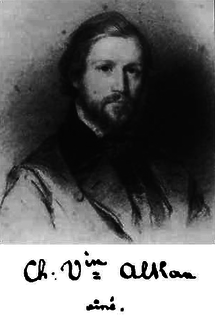Ludwig van Beethoven's Piano Sonata No. 3 in C major, Op. 2, No. 3, is a sonata written for solo piano, composed in 1795. It is dedicated to Joseph Haydn and is often referred to as Beethoven's first virtuosic piano sonata. The three Op. 2 sonatas all contain four movements each, an unusual length which seems to show that Beethoven was aspiring towards composing a symphony. It is both the weightiest and longest of the three Op. 2 sonatas, lasting over 25 minutes, presenting many difficulties, including difficult trills, awkward hand movements, and forearm rotation. It is Beethoven's second longest piano sonata in his early period, only to Beethoven's Grand Sonata in E♭ Major, Op. 7, published a year later.

C minor is a minor scale based on C, consisting of the pitches C, D, E♭, F, G, A♭, and B♭. Its key signature consists of three flats. Its relative major is E♭ major and its parallel major is C major.

G minor is a minor scale based on G, consisting of the pitches G, A, B♭, C, D, E♭, and F. Its key signature has two flats. Its relative major is B-flat major and its parallel major is G major.

D minor is a minor scale based on D, consisting of the pitches D, E, F, G, A, B♭, and C. Its key signature has one flat. Its relative major is F major and its parallel major is D major.

E minor is a minor scale based on E, consisting of the pitches E, F♯, G, A, B, C, and D. Its key signature has one sharp. Its relative major is G major and its parallel major is E major.

B minor is a minor scale based on B, consisting of the pitches B, C♯, D, E, F♯, G, and A. Its key signature consists of two sharps. Its relative major is D major and its parallel major is B major.

B♭ minor is a minor scale based on B♭, consisting of the pitches B♭, C, D♭, E♭, F, G♭, and A♭. Its key signature has five flats. Its relative major is D♭ major and its parallel major is B♭ major. Its enharmonic equivalent, A♯ minor, which would contain seven sharps, is not normally used.

E-flat minor is a minor scale based on E♭, consisting of the pitches E♭, F, G♭, A♭, B♭, C♭, and D♭. Its key signature consists of six flats. Its relative key is G-flat major and its parallel key is E-flat major. The direct enharmonic equivalent of E-flat minor is D-sharp minor, a key signature of six sharps.
The Études-Tableaux, Op. 39 is the second set of piano études composed by Sergei Rachmaninoff.
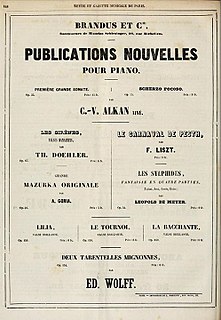
Grande sonate: Les quatre âges is a four movement sonata for piano by Charles-Valentin Alkan. The sonata's title refers to the subtitles given to each movement, portraying a man at the ages of 20, 30, 40, and 50. The work is dedicated to the composer's father, Alkan Morhange, and was published in 1847.
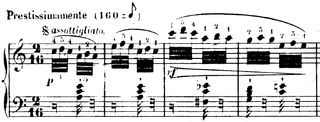
Comme le vent is the first of the Études in the minor keys, Op. 39 for solo piano by the French composer Charles-Valentin Alkan. It is in A minor. The tempo marking is prestissimamente, and the unusual 2
16 time signature further encourages a fast performance. The piece is mostly quiet, but is interrupted by short loud outbursts.
Concerto for Solo Piano is a 3-movement solo piano piece written by Charles-Valentin Alkan. The pieces are part of a 12 piece cycle entitled Douze études dans tous les tons mineurs, published in 1857. With sections marked "Tutti", "Solo" and "Piano", the piece requires the soloist to present the voices of both the orchestra and the soloist. The pianist Jack Gibbons comments: "The style and form of the music take on a monumental quality—rich, thickly set textures and harmonies ... conjure up the sound world of a whole orchestra and tax the performer, both physically and mentally, to the limit."
While a concerto is generally a piece for an instrument or instruments with orchestral accompaniment, some works for piano alone have been written with the seemingly contradictory designation concerto for solo piano.
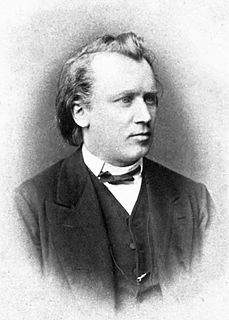
The Piano Quartet No. 3 in C minor, Op. 60, completed by Johannes Brahms in 1875, is scored for piano, violin, viola and cello. It is sometimes called the Werther Quartet after Goethe's The Sorrows of Young Werther.
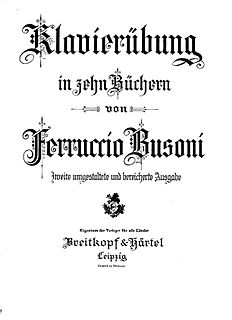
The Klavierübung, by the Italian pianist-composer Ferruccio Busoni, is a compilation of piano exercises and practice pieces, including transcriptions of works by other composers and original compositions of his own.
Esquisses (Sketches), Op. 63 is a set of 49 short piano pieces by French composer Charles-Valentin Alkan and published in 1861. The pieces are divided into four books; the first pair of books and the last pair each comprise between them pieces in each of all the major and minor keys. Book 4 ends with an extra, unnumbered, piece, Laus Deo, in C major.

There is a long tradition in classical music of writing music in sets of pieces that cover all the major and minor keys of the chromatic scale. These sets typically consist of 24 numbers, one for each of the major and minor keys.
En rhythme molossique is the second of the Études in the minor keys, Op. 39 for solo piano by the French composer Charles-Valentin Alkan, published in 1846. It is in D minor. The piece is in rondo form, with two episodes, and is mostly driven by the rhythm . Ronald Smith compares the theme, involving loud octaves in canon, to the minuet from Joseph Haydn's string quartet, Op. 76 No. 2.
The Symphony for Solo Piano is a large-scale romantic work for piano composed by Charles-Valentin Alkan and published in 1857.

